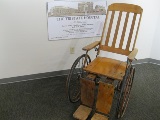Willis & Knighton

Willis & Knighton

Willis & Knighton

Willis & Knighton

Willis & Knighton

Willis & Knighton

Discover the men behind one the region’s most familiar household names. Who were Drs. Willis and Knighton, and what did they do for the field of medicine in their community? Exhibit highlights include original oil portraits of the medical giants, artifacts and material culture associated with their tenure and professional lives.
Wheelchair
Description
The modern wheelchair came into being in the mid-18th Century in England and was less for the disabled than the wealthy who didn’t want to walk around the English resort town of Bath. The concept however quickly evolved and soon those who couldn’t walk were using the “wheeled chair” on both sides of the Atlantic.
The wheelchair at the Talbot Museum probably dates from the early 20th Century, and according to oral tradition is thought to be part of Tri-State Hospital's original equipment.
Its style and construction, however, was common through most of the past 100 years. It is wood and metal with manually operated wheels or is pushed by an attendant. The bare wood was made more comfortable by cushions and padding which is now gone. Today there are a variety of “wheeled chairs”, using electric power with a variety of wheel types designed for rough ground as well as the hospital floor.
Location in Museum
Willis and Knighton ExhibitAge
Early 20th Century




